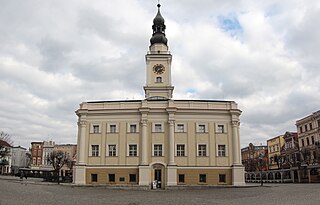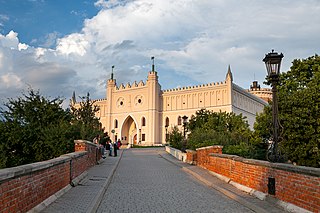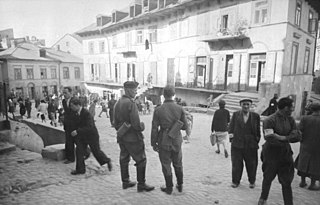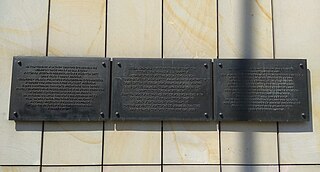This article has multiple issues. Please help improve it or discuss these issues on the talk page . (Learn how and when to remove these template messages)
|
The following is a timeline of the history of the city of Lublin, Poland.
This article has multiple issues. Please help improve it or discuss these issues on the talk page . (Learn how and when to remove these template messages)
|
The following is a timeline of the history of the city of Lublin, Poland.
| History of Poland |
|---|
 |
From the 6th century people started erecting their settlements on Grodzisko hill (Today called Castle Hill). Later the settlement had facilities for business and was servicing the Gord. [2]
In the eighth century, Hill Old Town was a place where a tribal stronghold was built.
Lublin is one of the oldest cities in Poland. According to both Dlugosz and Kadłubek the founding of the city took place in 810. The first preserved sources mention the name of the city however, only from the XII-XIII .: "de Lubelnia" (1198). "Lublin" (1224). [3] Sources are documents of ordinary official operations - the document attesting to the creation of the Lublin archdeaconry unit, forming part of the diocese of Kraków.






Lublin is the ninth-largest city in Poland and the second-largest city of historical Lesser Poland. It is the capital and the centre of Lublin Voivodeship with a population of 336,339. Lublin is the largest Polish city east of the Vistula River and is about 170 km (106 mi) to the southeast of Warsaw by road.

Radom is a city in east-central Poland, located approximately 100 kilometres south of the capital, Warsaw. It is situated on the Mleczna River in the Masovian Voivodeship. Radom is the fifteenth-largest city in Poland and the second-largest in its province with a population of 196,918 (30.06.2023)

Radomsko is a city in southern Poland with 44,700 inhabitants (2021). It is situated on the Radomka river in the Łódź Voivodeship. Located in the Sieradz Land, it is the county seat of Radomsko County.

Lubartów is a town in eastern Poland, with 23,000 inhabitants (2004), situated in Lublin Voivodeship. It is the capital of Lubartów County and the Lubartów Commune. Historically it belongs to Lesser Poland.

Ciechanów is a city in north-central Poland. From 1975 to 1998, it was the capital of the Ciechanów Voivodeship. Since 1999, it has been situated in the Masovian Voivodeship. As of December 2021, it has a population of 43,495.

Leszno is a historic city in western Poland, seat of Leszno County within the Greater Poland Voivodeship. It is the seventh-largest city in the province with an estimated population of 62,200, as of 2021.

Rawa Mazowiecka is a town in central Poland, with 16,090 inhabitants (2022). It lies in the Łódź Voivodeship and is the capital of the Rawa County.

The Lublin Castle is a medieval castle in Lublin, Poland, adjacent to the Old Town district and close to the city center. It is one of the oldest preserved royal residencies in Poland, initially established by High Duke Casimir II the Just. Its contemporary Gothic Revival appearance is largely due to a reconstruction undertaken in the 19th century.

The Lublin Ghetto was a World War II ghetto created by Nazi Germany in the city of Lublin on the territory of General Government in occupied Poland. The ghetto inmates were mostly Polish Jews, although a number of Roma were also brought in. Set up in March 1941, the Lublin ghetto was one of the first Nazi-era ghettos slated for liquidation during the deadliest phase of the Holocaust in occupied Poland. Between mid-March and mid-April 1942 over 30,000 Jews were delivered to their deaths in cattle trucks at the Bełżec extermination camp and additional 4,000 at Majdanek.

The Majdanek State Museum is a memorial museum and education centre founded in the fall of 1944 on the grounds of the Nazi Germany Majdanek death camp located in Lublin, Poland. It was the first museum of its kind in the world, devoted entirely to the memory of atrocities committed in the network of concentration, slave-labor, and extermination camps and subcamps of KL Lublin during World War II. The museum performs several tasks including scholarly research into the Holocaust in Poland. It houses a permanent collection of rare artifacts, archival photographs, and testimony.
The following is a timeline of the history of the city of Łódź, Poland.
The following is a timeline of the history of the city of Poznań, Poland.

The following is a timeline of the history of Warsaw in Poland.
The following is a timeline of the history of the city of Radom, Poland.
The following is a timeline of history of the city of Bydgoszcz, Poland.

Rury is one of the quarters of the city of Lublin, Poland located in the west-central part of the city. The district grew upon the hillside, former city fields, extending to Konopnica. From February 23, 2006 the district became an administrative region of Lublin.

The Lipowa 7 camp was a Nazi forced labor concentration camp, primarily for Jews, by Lipowa Street in Lublin, Poland during December 1939 - 1944. In November 1943 nearly all Jewish inmates were exterminated.

Bartosz (Bart)Staszewski (born 23 September 1990 in Malmö, Sweden) is a Polish filmmaker and LGBT activist. He is the creator of the documentary Article Eighteen, co-founder of the Equality March in Lublin association and the Miłość Nie Wyklucza foundation ('Love Does Not Exclude'), which promotes same-sex marriage in Poland. Staszewski was the target of death threats and intimidation in 2019 and 2021 in relation to his activism.
The following is a timeline of the history of the city of Płock, Poland.
The following is a timeline of the history of the city of Włocławek, Poland.
{{cite book}}: CS1 maint: location missing publisher (link){{cite book}}: CS1 maint: location missing publisher (link)